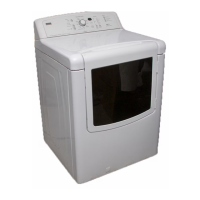Do you have a question about the Kenmore Oasis 110.67032600 and is the answer not in the manual?
Provides essential safety guidelines and warnings for operating the dryer.
Explains how to interpret the model and serial number format.
Shows the physical locations of the model and serial number label and the tech sheet.
Outlines the terms and conditions of the one-year limited warranty.
Lists required tools, parts, and provides general installation steps.
Specifies requirements for dryer placement, including clearances and floor stability.
Details recommended spacing for installation, including dryer dimensions.
Provides specific guidelines for installing the dryer in mobile homes.
Details electrical supply needs and connection methods for electric models.
Provides critical safety information on grounding the dryer for electrical safety.
Step-by-step guide for connecting a 4-wire power supply cord.
Step-by-step guide for connecting a 3-wire power supply cord.
Details requirements for gas supply lines, type, and connections.
Specifies requirements for installing a new dryer vent system.
Provides guidance on using or modifying an existing dryer vent system.
Outlines typical and optional dryer exhaust vent system installations.
Step-by-step instructions for installing the dryer's exhaust vent system.
Procedure for installing and adjusting the dryer's leveling legs.
Procedure to change the dryer door swing direction from right to left.
Final checks and initial operation procedures after installation.
Provides operating instructions and critical safety warnings for customers.
Basic steps to start the dryer, including cycle selection and time display.
Guide to selecting and using automatic and manual drying cycles.
How to manage cycles and general tips for optimal drying.
Explains the meaning of various status lights indicating dryer progress.
Details on preset cycles, temperatures, and times for optimal drying.
How to adjust dryer settings like dryness level, temperature, and options.
Instructions for using the included dryer rack for items that do not tumble.
Diagrams showing the locations of major components within the dryer.
Step-by-step guide to removing the user interface, machine control, and motor control units.
Procedure for accessing and removing the moisture sensor and front cabinet panel.
Instructions for removing heating elements, thermostats, and gas burner parts.
Procedure for removing the drive belt, the dryer drum, and associated rollers.
Steps to remove the blower fan and motor assemblies from the dryer.
Steps to remove the main drive motor and the belt switch.
How to test the door switch, thermal fuse, and outlet thermistor.
Procedures for testing thermostats, thermistors, heaters, and burner parts.
How to test gas burner coils, ignitor, flame sensor, and safety cutoffs.
Resistance testing for blower motor, belt switch, drive motor, and thermal overload.
Lists and explains diagnostic fault codes indicated on the dryer display.
Steps to enter diagnostic mode and resolve entry issues.
Tests console feedback for door switch, moisture sensor, motor, and heater.
Displays airflow, line voltage, and activates manual load test mode.
General notes on performing troubleshooting tests, emphasizing safety and tools.
Verifies proper electrical supply connections to the dryer's terminal block.
Tests if power is present at the machine control and if it is functional.
Tests the wiring and components of the drive motor system.
Tests the blower motor and its connections in dual motor configurations.
Steps to diagnose and resolve issues when the dryer fails to produce heat.
Tests the exhaust and inlet thermistors' resistance and function.
Tests the moisture sensor for proper operation, checking cycle timing.
Diagnoses issues where console buttons do not illuminate.
Activates a test mode to verify the door switch's response.
How to adjust default dryness levels for automatic cycles.
Step-by-step guide to removing the front panel and drum assembly.
Guides for accessing the user interface and machine control electronics.
Procedure for removing the main machine control board.
Steps to remove the motor control electronics on dual motor models.
Procedure for removing the user interface board and its components.
Lists and explains diagnostic fault codes for gas dryer models.
Steps to enter diagnostic mode and resolve entry issues on gas dryers.
Tests console feedback for door switch, sensor, motor, and heater on gas dryers.
Displays airflow, voltage, and activates manual load test mode for gas dryers.
General notes for performing troubleshooting tests on gas dryers.
Verifies electrical supply connections for gas dryers.
Checks power at machine control and its functionality in gas dryers.
Tests drive motor wiring and components for gas dryers.
Tests blower motor and its connections in dual motor gas dryers.
Steps to diagnose and resolve no-heat issues in gas dryers.
Tests the gas valve coil for resistance to detect failure.
Tests moisture sensor operation on gas dryers, checking for cycle timing issues.
Diagnoses issues with unlit console buttons on gas dryers.
Tests gas dryer door switch functionality via diagnostic mode.
Customizes drying modes and guides front panel removal on gas dryers.
Guides for accessing electronic components on gas dryers.
Procedure for removing the main control board on gas dryers.
Steps to remove motor controls on dual motor gas dryers.
Procedure for removing the user interface board on gas dryers.
Provides wiring diagrams for single and dual element electric dryer models.
Shows simplified strip circuits for electric dryer components.
Complete wiring diagram for gas dryer models.
Simplified strip circuits illustrating gas dryer components.
| Brand | Kenmore |
|---|---|
| Model Number | 110.67032600 |
| Capacity | 7.0 cu. ft. |
| Color | White |
| Dryer Venting | Vented |
| Number of Temperature Settings | 5 |
| Wrinkle Guard Option | Yes |
| Moisture Sensor | Yes |
| Drum Light | Yes |
| Power Source | Electric |
| Voltage | 240 V |
| Amperage | 30 A |
| Width | 29 inches |
| Control Type | Electronic |
| Type | Dryer |
| Weight | 120 lbs. |
| Drying Cycles | Delicates, Heavy Duty, Normal, Quick Dry, Sanitize, Towels |












